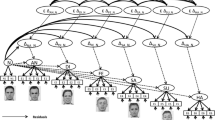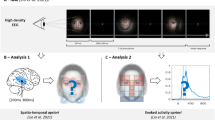Abstract
Facial expression of emotion is a key mechanism of non-verbal social communication in humans. Deficits in processing of facial emotion have been implicated in psychiatric disorders characterized by abnormal social behavior, such as autism and schizophrenia. Identification of genetically transmitted variability in the neural substrates of facial processing can elucidate the pathways mediating genetic influences on social behavior and provide useful endophenotypes for psychiatric genetic research. This study examined event-related brain potentials (ERPs) evoked by changes in facial expression in adolescent twins (age 12, 47 monozygotic and 51 dizygotic pairs). Facial images with happy, fearful, and neutral expressions were administered in a continuous mode, such that different expressions of the same face instantaneously replaced each other. This experimental design allowed us to isolate responses elicited by changes in emotional expression that were not confounded with responses elicited by image onset. Changes of emotional expression elicited a N240 wave with a right temporoparietal maximum and a P300 wave with a centropariatal midline maximum. Genetic analyses using a model fitting approach showed that a substantial proportion of the observed individual variation in these ERP responses can be attributed to genetic factors (36–64% for N250 and 42–62% for P300 components, respectively). This study provides the first evidence for heritability of neuroelectric indicators of face processing and suggests that ERP components sensitive to emotional expressions can potentially serve as endophenotypes for psychpathology characterized by abnormalities in social cognition and behavior.


Similar content being viewed by others
References
Adolphs R (2002) Neural systems for recognizing emotion. Curr Opin Neurobiol 12:169–177
Bediou B, Henaff MA, Bertrand O, Brunelin J, d’Amato T, Saoud M, Krolak-Salmon P (2007) Impaired fronto-temporal processing of emotion in schizophrenia. Neurophysiol Clin 37:77–87
Corden B, Critchley HD, Skuse D, Dolan RJ (2006) Fear recognition ability predicts differences in social cognitive and neural functioning in men. J Cogn Neurosci 18:889–897
Criado JR, Ehlers CL (2007) Electrophysiological responses to affective stimuli in Southwest California Indians: relationship to alcohol dependence. J Stud Alcohol Drugs 68:813–823
Dawson G, Webb SJ, McPartland J (2005) Understanding the nature of face processing impairment in autism: insights from behavioral and electrophysiological studies. Dev Neuropsychol 27:403–424
Ekman P (1976) Pictures of facial affect. Consulting Psychologists Press, Palo Alto
Ford JM, Gray M, Whitfield SL, Turken AU, Glover G, Faustman WO, Mathalon DH (2004) Acquiring and inhibiting prepotent responses in schizophrenia: event-related brain potentials and functional magnetic resonance imaging. Arch Gen Psychiatry 61:119–129
Gottesman II, Gould TD (2003) The endophenotype concept in psychiatry: etymology and strategic intentions. Am J Psychiatry 160:636–645
Grossmann T, Johnson MH (2007) The development of the social brain in human infancy. Eur J Neurosci 25:909–919
Haxby JV, Hoffman EA, Gobbini MI (2002) Human neural systems for face recognition and social communication. Biol Psychiatry 51:59–67
Henson RN, Goshen-Gottstein Y, Ganel T, Otten LJ, Quayle A, Rugg MD (2003) Electrophysiological and haemodynamic correlates of face perception, recognition and priming. Cereb Cortex 13:793–805
Jeste SS, Nelson CA 3rd (2009) Event related potentials in the understanding of autism spectrum disorders: an analytical review. J Autism Dev Disord 39:495–510
Johnston PJ, Stojanov W, Devir H, Schall U (2005) Functional MRI of facial emotion recognition deficits in schizophrenia and their electrophysiological correlates. Eur J Neurosci 22:1221–1232
Kasriel J, Eaves L (1976) The zygosity of twins: further evidence on the agreement between diagnosis by blood groups and written questionnaires. J Biosoc Sci 8:263–266
Kohler CG, Turner TH, Bilker WB, Brensinger CM, Siegel SJ, Kanes SJ, Gur RE, Gur RC (2003) Facial emotion recognition in schizophrenia: intensity effects and error pattern. Am J Psychiatry 160:1768–1774
Kohler CG, Walker JB, Martin EA, Healey KM, Moberg PJ (2009) Facial emotion perception in Schizophrenia: a meta-analytic review. Schizophr Bull [Epub ahead of print]
Leppanen JM, Nelson CA (2009) Tuning the developing brain to social signals of emotions. Nat Rev Neurosci 10:37–47
Liu J, Harris A, Kanwisher N (2002) Stages of processing in face perception: an MEG study. Nat Neurosci 5:910–916
Mandal MK, Ambady N (2004) Laterality of facial expressions of emotion: Universal and culture-specific influences. Behav Neurol 15:23–34
Marsh AA, Blair RJ (2008) Deficits in facial affect recognition among antisocial populations: a meta-analysis. Neurosci Biobehav Rev 32:454–465
Marsh AA, Finger EC, Mitchell DG, Reid ME, Sims C, Kosson DS, Towbin KE, Leibenluft E, Pine DS, Blair RJ (2008) Reduced amygdala response to fearful expressions in children and adolescents with callous-unemotional traits and disruptive behavior disorders. Am J Psychiatry 165:712–720
McPartland J, Dawson G, Webb SJ, Panagiotides H, Carver LJ (2004) Event-related brain potentials reveal anomalies in temporal processing of faces in autism spectrum disorder. J Child Psychol Psychiatry 45:1235–1245
Monk CS, Klein RG, Telzer EH, Schroth EA, Mannuzza S, Moulton JL 3rd, Guardino M, Masten CL, McClure-Tone EB, Fromm S, Blair RJ, Pine DS, Ernst M (2008) Amygdala and nucleus accumbens activation to emotional facial expressions in children and adolescents at risk for major depression. Am J Psychiatry 165:90–98
Neale MC, Cardon LR (1992) Methodology for genetic studies of twins and families, vol 67. Kluwer Academic Publishers, Dordrecht
Neale MC, Boker SM, Xie G, Maes HH (2002) Mx: statistical modeling, 6th edn. Department of Psychiatry, Richmond
Posamentier MT, Abdi H (2003) Processing faces and facial expressions. Neuropsychol Rev 13:113–143
Rijsdijk FV, Sham PC (2002) Analytic approaches to twin data using structural equation models. Brief Bioinform 3:119–133
Sagiv N, Bentin S (2001) Structural encoding of human and schematic faces: holistic and part-based processes. J Cogn Neurosci 13:937–951
Schneider F, Gur RC, Koch K, Backes V, Amunts K, Shah NJ, Bilker W, Gur RE, Habel U (2006) Impairment in the specificity of emotion processing in schizophrenia. Am J Psychiatry 163:442–447
Semlitsch HV, Anderer P, Schuster P, Presslich O (1986) A solution for reliable and valid reduction of ocular artifacts, applied to the P300 ERP. Psychophysiology 23:695–703
Tate AJ, Fischer H, Leigh AE, Kendrick KM (2006) Behavioural and neurophysiological evidence for face identity and face emotion processing in animals. Philos Trans R Soc Lond B Biol Sci 361:2155–2172
Turetsky BI, Kohler CG, Indersmitten T, Bhati MT, Charbonnier D, Gur RC (2007) Facial emotion recognition in schizophrenia: when and why does it go awry? Schizophr Res 94:253–263
Vogel F (1981) Neurobiological approaches in human behavior genetics. Behav Genet 11:87–102
Vuilleumier P, Pourtois G (2007) Distributed and interactive brain mechanisms during emotion face perception: evidence from functional neuroimaging. Neuropsychologia 45:174–194
Webb SJ, Dawson G, Bernier R, Panagiotides H (2006) ERP evidence of atypical face processing in young children with autism. J Autism Dev Disord 36:881–890
Williams LM, Hermens DF, Palmer D, Kohn M, Clarke S, Keage H, Clark CR, Gordon E (2008) Misinterpreting emotional expressions in attention-deficit/hyperactivity disorder: evidence for a neural marker and stimulant effects. Biol Psychiatry 63:917–926
Wong TK, Fung PC, Chua SE, McAlonan GM (2008) Abnormal spatiotemporal processing of emotional facial expressions in childhood autism: dipole source analysis of event-related potentials. Eur J Neurosci 28:407–416
Acknowledgments
This work was supported by the grant DA018899 from the National Institute on Drug Abuse.
Author information
Authors and Affiliations
Corresponding author
Additional information
Edited by Kristen Jacobson.
Rights and permissions
About this article
Cite this article
Anokhin, A.P., Golosheykin, S. & Heath, A.C. Heritability of Individual Differences in Cortical Processing of Facial Affect. Behav Genet 40, 178–185 (2010). https://doi.org/10.1007/s10519-010-9337-1
Received:
Accepted:
Published:
Issue Date:
DOI: https://doi.org/10.1007/s10519-010-9337-1




